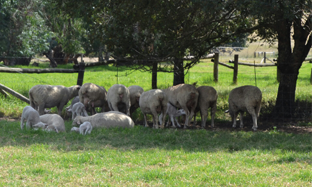
The Johne’s Disease Vaccine (Gudair) is a highly effective once-off vaccine that protects the animal for life.
Ovine Johne's Disease (OJD) is a serious threat to South Africa's sheep industry. Greater concern is the absence of a national plan to deal with it. In the meantime, and while the logistics are thrashed out, there's a great deal farmers can do to protect their flocks from infection or further loss.
The Small Stock Health Advisory Body is a strong advocate for the development of a national strategy for the control of Johne's disease.
There is no shame in having Johne's on your farm. The shame lies in, having it, and not saying so.
The biggest challenge is developing a reliable test. There is no use in trying to control the problem until you know how big it is. You can't judge by the number of reported cases - farmers don't notify their local or State vets for fear of being quarantined. What we do know is that it is very widespread, probably more so than many people are willing to admit. In the meantime, farmers are urged to grasp the nettle and get on with a programme of Johne’s disease control.
Keeping quiet about having a positive flock is one way of spreading the disease throughout your flock and to other farms, particularly if you are a ram breeder. So, learn to recognize the symptoms and embark on a programme of control.
SYMPTOMS OF JOHNE'S DISEASE
Ovine Johnes disease is basically tuberculosis in sheep. It manifests in the gut, leading to a thickening of the gut wall and hence an inability to absorb nutrition. Essentially then, although the sheep continues to eat…..it dies of hunger. There is a gradual wasting away; a slow loss of condition that leads to emaciation and ultimately death, Sometimes this is accompanied by diarrhoea , wool loss or signs of bottle jaw. The disease is spread via the faeces of infected animals, and the bacteria can live in the ground for two years or longer.
The incidence of Johne's is stress related. It first surfaces in animals no younger than 12-14 months and at times of stress, for example, droughts or lambing, or in times of lactation stress.
There are no reliable blood tests so a positive diagnosis is made on the basis of a post mortem. A vet takes a tissue sample from the affected gut and analysis it hystologically. If you notice inexplicably emaciated sheep on your farm take one to your local veterinarian to find out if it's Johne's. Either bring in a live animal for the Vet to slaughter or bring in a fresh carcass. Slaughter is the only solution.
HOW TO MANAGE A POSITIVE FLOCK
Your first line of defence Is vaccination.
If you have an animal diagnosed with Johne's, it means your whole flock is vulnerable and you need to take action.
The good news is that there is a highly effective, once-off, vaccine (Gudair) that protects the animal for life. Indeed, without vaccination, you cannot control the disease. The vaccination prevents uninfected animals from getting infected, but Is not a cure for already infected animals.
While the vaccine does not cure positive animals., it does reduce the amount of infective bacteria in their faeces by 90% . So asymptomatic sheep positive animals that are vaccinated, become less infective to the rest of the flock. Broad vaccination of the whole flock is therefore an excellent way to control the spread of the disease.
As with all infectious diseases, younger animals are more susceptible. The younger an animal is when vaccinated the better. Vaccinate ewe lambs at tailing.
The vaccine is available only through a Vet on prescription from the State Vet, and a record is kept of vaccinated farms.
Second line of attack eradicate the sick.
You must slaughter those animals that appear affected or sell them to a registered abattoir as: soon as possible. Not only will they continue to get thinner, but they're also spreading the disease via their faeces. The sooner you can pick them out the better - pricewise and in terms of the amount of infective bacteria being deposited on your pastures. Importantly the meat of infected animals is fit for human consumption.
The outlook:
In the last 15 years there has been a huge increase in the number of cases in the Western and Eastern Cape. What is encouraging is that on farms where that have been vaccinated, dramatic reductions in mortalities have been noticed. Vaccination on farms for a few years now have shown very good results. In some instances all mortality of young ewes has almost completely stopped. We hope that in five years there will be no cases there at all.
There is an advantage to living where Johne's disease is prevalent and people have admitted to the problem, Those farmers are confident about embarking on programmes of vaccination and are noticing a dramatic downturn in be number of clinical cases. Having admitted to the problem, they can go about controlling or even solving it.
Countries such as Australia have battled long and hard to control Johne's disease. It is vital for South Africa to learn from their successes and failures while it thrashes out its own national strategy.
And while it does, vaccinate...
Acknowledgement to Dr Ian Herbst, Caledon.
Written by Peta Aston-prior.

